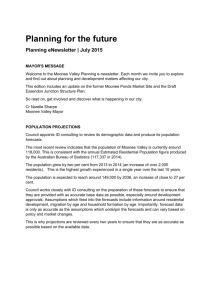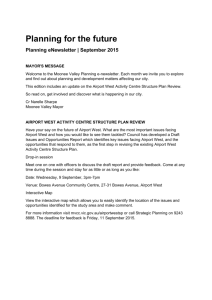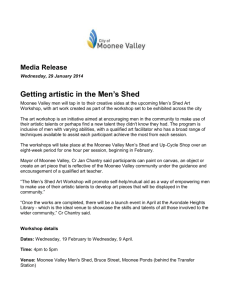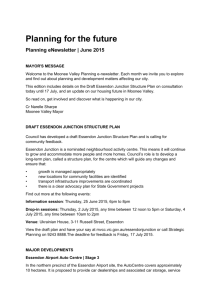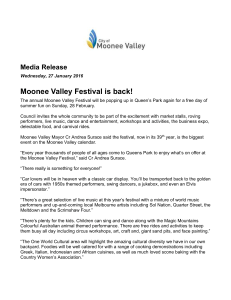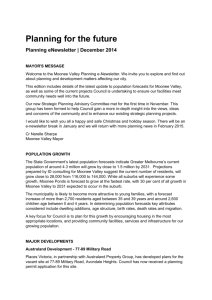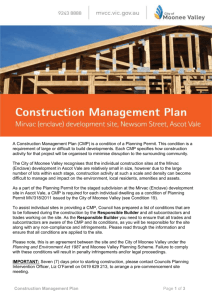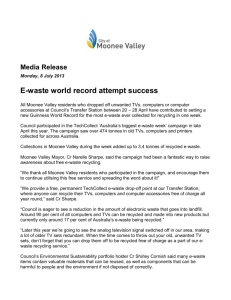How the Community Vision was developed
advertisement
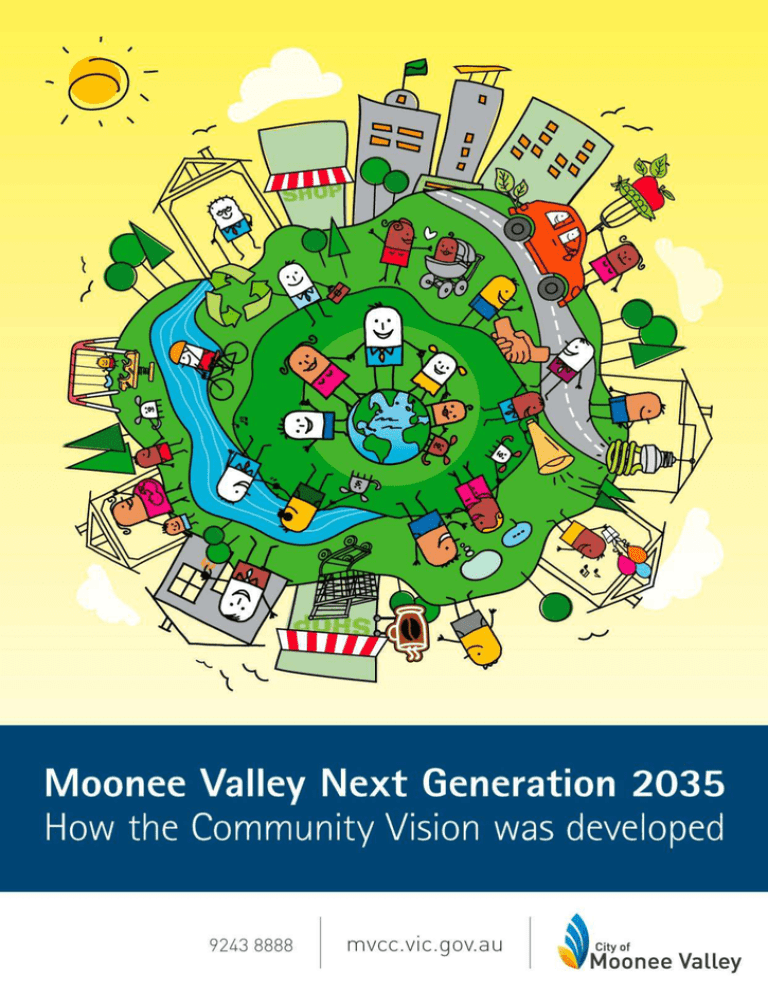
Moonee Valley Next Generation 2035 How the community vision was developed CONTENTS INTRODUCTION ........................................................................................................ 2 THE RESEARCH DESIGN ........................................................................................ 5 Community engagement and data collection activities ........................................... 6 Demographics of survey respondents .................................................................. 10 Data analysis ........................................................................................................ 13 THE RESEARCH RESULTS .................................................................................... 15 Theme one: Friendly and safe .............................................................................. 15 Theme two: Green, clean and beautiful ................................................................ 17 Theme three: Sustainable living ........................................................................... 20 Theme four: Vibrant and diverse .......................................................................... 23 Other challenges................................................................................................... 25 CONCLUSION ......................................................................................................... 27 2 FIGURES AND TABLES Figure one: The frequency of words in response to question two, all survey respondents ............................................................................................................... 6 Figure two: The frequency of words in response to question two, youth summit ....... 8 Table one: Respondent numbers from community engagement activities ............... 10 Figure three: The age distribution of survey respondents ........................................ 11 Figure four: The postcode distribution of respondents ............................................. 12 Figure five: The frequency of key words used to describe Moonee Valley in 2035 .. 13 Figure six: Frequency of terms relating to challenges and opportunities .................. 14 Figure seven: Statements regarding safety .............................................................. 16 Figure eight: Statements about friendliness ............................................................. 17 Figure nine: Statements about green ....................................................................... 18 Figure ten: Statements about clean ......................................................................... 19 Figure eleven: Statements regarding residential development ................................. 22 Figure twelve: Statements regarding mobility ........................................................... 23 Figure thirteen: Statements about vibrancy and diversity ......................................... 24 3 INTRODUCTION In 2012 Moonee Valley City Council undertook a range of community engagement processes to update its long term Community Vision. The aim of Moonee Valley Next Generation 2035 was to identify a vision for Moonee Valley that the community can expect to see used as an overarching guide to Council planning, advocacy and decision making. It can also be used to inform broader partnerships and action on key community concerns. This report is intended to complement the Moonee Valley Next Generation 2035 Draft Community Vision. It details the research methodology and analysis used to develop the Vision of Moonee Valley in 2035 as a city of clean, green and beautiful, vibrant, diverse and sustainable communities that people experience as friendly and safe to live in. The specific objectives of Moonee Valley Next Generation 2035 community consultation were to: Develop and document a shared vision for our future Encourage active democracy by strengthening the links between council decisions and community aspirations Encourage broad community engagement through a range of participatory processes Moonee Valley is a diverse community of people whose range of views and interests is broad. We wanted to ensure this breadth of views contributed to the vision for Moonee Valley Next Generation 2035. For these reasons we sought to implement a research strategy that would capture the geographic and cultural diversity of the municipality, and engage participation from people across all life stages. The following sections describe the research methodology and the data collection and analysis processes that were adopted to meet these objectives. 4 THE RESEARCH DESIGN In line with the aim to identify and develop broad themes that would underpin a vision for Moonee Valley in 2035, this research adopted a qualitative methodology. This methodological approach was deemed the most appropriate for achieving the research aims of developing a long term and shared vision, which strengthens links between Council decisions and community aspirations. This is because qualitative methods can be used to encourage the kind of conceptual thinking a shared vision requires. They are also an appropriate means through which to make inferences about a large group of people based on data drawn from a smaller sample of that population. A mix of data collection methods were used; including a survey, forums and reference groups, and drawings. In each case we used open ended questions so as to refrain from constraining view points or from asking respondents to select from already established ideas. The key questions we asked were: 1. I would like Moonee Valley in 2035 to be… 2. When I picture Moonee Valley in 2035, the three words that should describe my city are… 3. To complete my picture I think what most needs to change is… 4. I think the major challenges and opportunities in Moonee Valley over the next twenty five years are… These questions were designed to elicit both broad and focused thinking. In particular the selective responses to the ‘three words’ of question two, facilitated the identification of key themes, using frequency as one means of assessing the importance of issues. These key themes are illustrated in figure one. The challenges and opportunities the city faced in achieving those vision themes were then able to be elaborated upon through the greater detail provided in the other three questions. The community engagement processes aimed to engage with a people across Moonee Valley. It is considered that these methods were successful in obtaining views from range of people, with over 1000 people participating. To further ensure the validity of the Vision themes, a second round of research consultation is planned for the 9th to 31st of July 2012. The intention of that consultation is to gain feedback on the draft Community Vision, and to determine if the community feels it adequately reflects their picture for Moonee Valley in 2035. 5 Figure one: The frequency of words in response to question two, all survey respondents Community engagement and data collection activities One of the objectives of the research design was to encourage broad community engagement through a range of participatory processes. This section provides a description of the methods adopted to inform the community about the consultation and encourage them to share their vision. It also details the numbers of responses garnered through the survey, forums, references groups and drawing activities, and the different locations across the community we visited. The consultation period ran for three months, from March until the end of May, 2012. Moonee Valley 2035 reached over 40,000 households through the Valley View magazine, which is distributed directly to letterboxes. News articles and notifications describing the Vision consultation and explaining ways to become involved were published in the local area newspapers the Moonee Valley Leader and the Moonee Valley Weekly. In total 1,123 people directly participated in one or more of the community engagement methods. This included 876 people who responded using the survey. Almost 250 additional people provided their views and feedback in other ways, such as through children’s drawings, videos featuring the Community Ambassadors and other community volunteers, and an Organisational Leaders Forum. The different engagement and data collection methods are discussed in the following section. 6 The survey The main means of collecting data from the community was through a short survey. It was distributed in hard copy and made available online. A postcard focusing on the question ‘I would like Moonee Valley in 2035 to be...’ was created for distribution at events where lengthy engagement may have been more difficult to secure. All printed versions were able to be returned to Council postage paid or left in special Vision boxes placed in libraries, the Council office and other venues. A deliberate effort was made to involve different ethnic groups and all parts of the municipality. This included taking Moonee Valley 2035 to over 20 different community events such as the Moonee Valley Festival, a Children’s Expo, the Mediterranean Festival in Keilor East and Harmony Day in Flemington. Translated posters were used to promote the consultation in languages other than English. Translated questionnaires meant people could complete the survey in languages including Somali, Arabic Chinese, Vietnamese, Greek and Italian reflecting the major languages in the community. Interpreters also assisted people to complete the survey in other languages attending cultural events such as a lunch celebrating a Buddhist festival at Flemington Community Centre. A Moonee Valley Next Generation 2035 web page was created. People could comment on specific questions, complete the survey online, or view what others were saying in the online discussion forum and in two videos created for the project. The first video featured volunteers from across the municipality talking about their vision for Moonee Valley along with ideas about the challenges and opportunities ahead. These volunteers were recruited using snowball methods through community agencies and asking people who had won awards for service to the Moonee Valley community. Click here to view this video, or go to www.mvcc.vic.gov.au/mv2035. Moonee Valley businesses and organisations also helped to promote the Community Vision consultation, including: Victoria University, who highlighted Moonee Valley 2035 on their Internet home page and emailed staff and students Moonee Valley Traders Associations, who emailed members encouraging them to complete a survey Doutta Galla Community Health Service, who highlighted Moonee Valley 2035 on their web page, encouraged clients to participate in a focus group discussion, and provided a detailed submission A local Neighbourhood Learning Centre, who used the survey as an exercise in their English Language classes. 7 Engaging with children and young people Several strategies were adopted to engage children and young people. This was deemed particularly important as they will be the adults living in the Moonee Valley in 2035. Education leaders used their networks at Victoria University and area schools to encourage young people to complete the survey. There was also active promotion of the survey at the youth oriented Sounds Loud festival. A Youth Summit involving 50 young people aged between 11 and 18 years also included a specially designed Moonee Valley 2035 workshop. Two thirds of Youth Summit participants lived as well as studied in Moonee Valley and just over half were 12 or 13 years of age. Youth Summit participants were invited to articulate their responses to each of the four Moonee Valley 2035 survey questions on post it notes. The post it notes were shared on butchers’ paper posted to the wall for informal discussion over the course of the day. While not all Youth Summit participants participated in the exercise a total of 72 post it notes were submitted responding to the survey questions. The word cloud in figure two gives a visual impression of the key words used to ‘describe my city’. These words reflect key themes noted in other young people’s responses to Moonee Valley 2035, as well as those raised by the broader sample (see figure one). Figure two: The frequency of words in response to question two, youth summit The views of younger children were sought by asking children to draw My Dream for Moonee Valley. This exercise was primarily conducted at the Moonee Valley Festival and also in some preschools. A total of 80 drawings were obtained from children age from 1 to 11 years and from areas across Moonee Valley. This included 13 from Moonee Ponds, 12 from Essendon, 5 from Keilor East, 4 each from Airport West, Niddrie and Avondale Heights, 3 from Strathmore and 2 from Ascot Vale. There were an additional 33 drawings by other children. 8 Reference groups A critical component of the process was the establishment of internal and external project reference groups. They included an Internal Council Officers Working Group and a Community Ambassadors Group. These two groups served to identify potential opportunities for engagement, provided direct feedback to the research team throughout the community engagement process, and utilised their networks in education, community, sports and business to encourage community participation. Community leaders, entrepreneurs, educators, business people and service providers from across Moonee Valley were invited by the Mayor to participate in the Community Ambassadors Group. A number also articulated their personal vision for Moonee Valley along with ideas about the challenges and opportunities ahead in a second video created as part of the project. Click here to view this video, or go to www.mvcc.vic.gov.au/mv2035. Several ambassadors also shared their views in local newspaper coverage sought to encourage community engagement in the project. At the conclusion of the community engagement process 150 senior staff of Moonee Valley City Council participated in an Organisational Leaders Forum. This enabled Council leaders to look at the community’s aspirations for the City. The discussion confirmed the need for cross Council action and to involve the community in developing these responses. Responses The number of responses garnered through these different engagement efforts is detailed in table one. Hard copy surveys that were completed and mailed to the Council office gave us the highest number of responses. Online participation was comparatively low, in particular in the discussion forum. This suggests that despite promotion on websites such as that of Victoria University, that online was not particularly effective in encouraging a direct response. The research team is satisfied that the volume of data collected was sufficient to develop themes that are reflective of the vision of the community, with reliability evaluated using the principle of saturation. That is, when new data reinforces ideas of earlier respondents, rather than contributing new concepts, data collection is considered to have reached the point of saturation. The following sections provide more details on the demographics of these respondents, and then outline the methods of data analysis used to develop the community vision. 9 Data collection activities Survey received through mail Survey completed online Participant in online forum Bowes Avenue Community Centre Flemington Community Centre Doutta Galla Community Centre Farnham Street Community Centre Multi Faith network Gateway cafe Moonee Valley festival Sounds Loud festival Mediterranean festival Harmony Day Children’s Expo Volunteer’s Lunch Youth Summit Early Years Teachers Forum Moonee Valley Council staff induction Community DVD Community Ambassadors DVD Children’s images Organisational Leaders Forum Total Respondents 288 71 4 37 43 2 18 3 9 67 79 26 15 66 51 50 43 4 8 9 80 150 1123 Table one: Respondent numbers from community engagement activities Demographics of survey respondents Demographic data collected told us where people lived, if they were a resident, a worker, a student or a visitor to Moonee Valley, how old they were and whether they were male or female. This data enabled us to evaluate the extent to which we achieved our objective of encouraging broad engagement with the community. This section describes the demographics of the research sample, concentrating on those who completed the survey. The age distribution of respondents is broadly representative of the population. Those in the 35 to 49 year old age bracket were our largest respondent group, making up just over 25% of total respondents. Around 10% of survey respondents did not provide their age. The age break down of respondents is presented in figure three, and compared to data from the 2011 census. 10 30 25 20 15 10 5 0 0 to 4 5 to 11 12 to 17 18 to 24 25 to 34 35 to 49 50 to 59 60 to 69 70 to 84 Respondents % 85 + Not stated 2011 Census Figure three: The age distribution of survey respondents Of the survey respondents, 70% were female, 27% male, and 3% did not state their gender. This is a higher representation of women than in the Moonee Valley population, which was 51.5% at the 2011 census. To evaluate this limitation for its impact on the data, we explored each of the key themes according to gender. The key issues to which women tended to give greater emphasis was evident in statements of beauty, and friendliness, and safety. This was seen in comments on the safety of children and elderly and the desire for a supportive and inclusive community. It is important to note that these differences are not large and we are confident the higher representation of women has not adversely shaped the development of the vision. We also collected postcode data, and the distribution of respondents according to their Moonee Valley residential postcode is detailed in figure four. Almost 80% of contributors to the development of the 2035 vision lived in the Moonee Valley area. A further 27 % worked in the region, with 17% of respondents living and working in the municipality. An additional 12% of respondents lived outside the municipality and either work in the area, or visit it for recreational purposes. This data from visitors has been retained, as the perspective of those who use the area for recreational or socialising purposes recognises the permeability of municipal boundaries. 11 160 140 120 100 80 60 40 20 0 3031 3032 3033 3034 3039 3040 3041 3042 Other Not stated Figure four: The postcode distribution of respondents1 As figure four demonstrates, we had a higher number of responses from residents living in the Essendon and Moonee Ponds postcode areas, at around 18% and 15% respectively. However overrepresentation of issues relating to these suburbs did not appear as a bias within the data. This is likely to reflect that the questions were constructed to encourage respondents to consider issues broadly, rather than focus on specific aspects of their immediate residential area. Further, whilst some respondents specifically mentioned aspects of Moonee Ponds or Essendon they felt needed attention from Council, e.g., the junction at Mt Alexander road, or pedestrian safety in North Essendon shopping village, specific reference to other suburbs were also noted within the data. Finally, the process of analysis aimed to categorise data in ways to ensure that specific references were related to the general themes. For example requests for attention to the Mt Alexander road junction were viewed as examples of the broader concern regarding traffic and congestion expressed by many respondents from across the municipality. The following section describes the data analysis processes used to determine these categorisations in more detail. 1 The suburbs that relate to these different postcode areas are as follows. 3031, Flemington and Kensington; 3032, Ascot Vale, Highpoint City, Maribyrnong, and Travancore; 3033, Keilor East; 3034, Avondale Heights; 3039, Moonee Ponds; 3040, Aberfeldie, Essendon and Essendon West; 3041, Essendon Fields, Essendon North, Strathmore and Strathmore Heights; 3042, Airport West, Keilor Park and Niddrie. 12 Data analysis The analysis process followed standard methods of analysis for qualitative data. Inductive processes were used to identify key themes in the data, making particular use of the three words respondents used to describe their ‘picture of Moonee Valley in 2035’ in Question Two of the questionnaire. Using basic summative processes, such as determining the frequency of use of specific terms, highlighted the key themes that formed the basis of the overall vision. This is demonstrated in the word frequency cloud at figure one and the frequency of the key words that underpinned the Vision themes, shown in figure five. 180 160 140 120 100 80 60 40 20 0 Safe Green Friendly Clean Community Vibrant Beautiful Family Sustainable Figure five: The frequency of key words used to describe Moonee Valley in 2035 Elaborating on the underlying intent of these commonly used terms required detailed consideration of the data. This process of identifying key words was therefore followed by a more detailed analysis of all data, to draw out the relationships between issues and build themes. This process drew on linkages between key words and themes they represented, and the greater detail provided in the sections on challenges and opportunities. This type of indepth investigation was considered important to the transparency of the research, and the integrity of the Moonee Valley 2035 Vision. 13 This was important because frequently used terms such as friendly were used in a variety of ways that required unpacking. People used the term to describe usability in general, expressing a desire for a municipality that was old-aged friendly or bicyclefriendly. They also used friendly to describe Moonee Valley as a supportive, caring and inclusive community, or to acknowledge and appreciate it as a vibrant and happy city. These usages were also related to opportunities, such that supporting arts and cultural activities was proposed as a means of enhancing both vibrancy and inclusivity. Thus whilst the first usage of the term friendly is mostly instrumental, the latter two tell us important things about the values that respondents wish to ‘feel’ in the Moonee Valley community and offer insight into ways to achieve that. The importance of unpacking the relationship between these issues was highlighted by an initial analysis of themes arising from responses about what most needed to change, and identifying challenges and opportunities. In this analysis, statements about broad concepts such as green, safe and friendly were replaced with more concrete concerns, such as traffic congestion, high rise development, and public transport. This shift is demonstrated in figure six, which shows the frequency of terms used in questions three and four of the survey. Understanding the relationship between these very present issues, and respondent’s aspirations for Moonee Valley in 2035, was a key objective of the data analysis. Figure six: Frequency of terms relating to challenges and opportunities A qualitative data analysis program called NVivo was utilised to assist in this process and promote rigour of analysis. This program enables classification of data in ways that can facilitate cross referencing between emerging themes and different elements of the data, such as the demographics of specific respondents. Using this program made it easier to extrapolate on the links between themes, and to more closely capture the interrelated nature of many of the challenges and opportunities that face Moonee Valley that respondents described. The following sections describe the results of this analysis. 14 THE RESEARCH RESULTS Methods of inductive analysis, as discussed above, were used to identify key overarching themes. These were then elaborated upon to develop the community vision. These key themes were as follows: Friendly and Safe Green, Clean and Beautiful Sustainable living Vibrant and Diverse. The following section describes the data in relation to these themes. Theme one: Friendly and safe Safe The term safe was the most commonly used term respondents used to describe their picture of Moonee Valley in 2035; at 21 %. Analysis of data shows that the majority of all references to safety (67%) were made in broad terms or without a specific contextual reference (see also figure seven). This highlights that safety issues are top of mind for many Moonee Valley residents and visitors. Some respondents also used terms like violence and crime to raise general concerns about safety. Specific statements regarding safety were related to the following areas: Making public spaces safe for specific groups of people, such as children and the elderly Pedestrian safety, particularly around road crossings, on uneven footpaths, and in some public spaces at night The safety of cyclists Public transport safety, both on services, and around public transport stops/stations Requests for increased police presence The management of graffiti, which was also related to cleanliness. 15 400 300 200 100 0 Safe, general or unclear Crime and police Groups of people Pedestrian and public transport safety Safety in public space Graffiti Figure seven: Statements regarding safety When considering statements regarding safety across age and postcodes, we saw some evidence of increased concerns among older respondents, and residents of Keilor East. However almost 50% of 12 to 17 year olds and 25 to 34 year olds were also concerned with safety; suggesting a broad concern or desire for a safe living environment. Friendly The issue of friendliness was more multifaceted than that of safety, nonetheless, it was clearly an important issue with 15% of respondents using the term as part of their statement of a vision. Friendly was able to be further defined as follows. Friendly as happy, welcoming, and fun; with a sense of energy Friendly as supportive, caring, inclusive; with a sense of acceptance. The experience of friendliness as happy and fun appears to be associated with the theme of vibrancy. Descriptors such as caring, supportive, and inclusive describe a softer version of friendliness, and appear to be connected with notions of safety and security. Both these ways of using the term ‘friendly’ capture a vision of the city as diverse and multicultural, with a sense of community or civic spirit, and that creates opportunities for all of its residents. It is important therefore to remember that these two broad usages are interrelated and are best understood as a description of the types of emotional connection and experiences of interaction that people desire. The frequency of use of these different understandings of friendliness is displayed in figure eight. 16 300 250 200 150 100 50 0 Friendly and happy general or unclear Community general or unclear Supportive, caring, inclusive Welcoming, engaging, creating opportunities Community or civic spirit Figure eight: Statements about friendliness Within these statements of friendliness we see a tendency for younger people to be more likely to use it in ways that could be interpreted as happy or fun. Older respondents and residents in areas of high ethnic and socio-economic diversity were more likely to be concerned with experiences of inclusion and support. Some respondents also spoke to these issues of friendliness in their discussions of opportunities, asking for greater investment in community centres and programs, libraries, and public spaces that can support socialising. Theme two: Green, clean and beautiful Green ‘Green’ was the second most common term used by respondents (16%) to describe their ‘picture of Moonee Valley in 2035’. There were two clearly identifiable links between the term green and the concepts in the data. These related to the green spaces of the municipality; its parks and trees, and a concern with environmental sustainability. Of these two areas, more than half of all statements regarding green related to the parks, gardens and trees of Moonee Valley, as is clearly demonstrated in figure nine. 17 600 500 400 300 200 100 0 Parks, open space, trees Environmental sustainability Green, general or unclear Figure nine: Statements about green Specific areas of concern regarding parks related to: Availability of open and green space, particularly with regard to increasing density Maintenance of existing parks, playgrounds and street trees including o More (and different) trees o Community gardens and farmers markets o Dog off lead areas o Activities within parks o Cleanliness. The specific areas of concern regarding environmental sustainability related to: The environmental implications of increased population density and how this is managed, e.g., pollution implications of increased traffic congestion, rubbish implications of increased density A desire for a Council that leads the way in promoting environmental sustainability, e.g., renewable energy, green building design, recycling and waste management, increased cycling and pedestrian infrastructure to encourage less car usage. The desire for the protection and maintenance of parks, open spaces and trees was broadly spread across the municipality, but concentrated among older age groups. A comparatively greater concern for environmental sustainability was expressed by respondents within the postcode areas of Keilor East and Moonee Ponds. The basis for this emphasis was not clear. 18 Children’s drawings also showed a strong focus on the natural environment with many drawings featuring flowers, trees, ‘space to run around in’, and play equipment such as swings and slides. Many children drew animals, trees and water near buildings and objects such as traffic lights highlighting their perception of living in an urban environment, but still being connected to its natural elements. The drawings were consistent with previous City of Moonee Valley consultations with children highlighting themes of play, water, nature and animals and of integrating built form with the natural elements. Clean The cleanliness of the city was also an important issue for respondents, with 14% using the word ‘clean’ to describe their Vision for Moonee Valley. Again, the majority of these references (approx 60%) expressed a desire for a ‘clean’ city without reference to specific concerns, as figure ten shows. References to cleanliness of specific places and things were as follows: Rubbish removal in general Concerns regarding increasing pollution and its potential impacts Requests for cleaner streets and parks Greater promotion of recycling in public spaces and at home The cleanliness of the Maribyrnong River and Moonee Ponds Creek. 250 200 150 100 50 0 Clean, general or unclear Rubbish and recycling Pollution Specific places Figure ten: Statements about clean We see a greater emphasis on cleanliness in postcode areas of 3034 (Avondale Heights) and 3041 (Essendon Fields, Essendon North, Strathmore, Strathmore Heights). However a desire for a clean environment is expressed across all age groups, including in the drawings of the very young. 19 Beautiful A third theme that was related to green and clean was the concept of Moonee Valley as a beautiful and pleasant environment in which to live. The term beautiful was explicitly used by 5% of respondents as an expression of their desired vision. More general ideas of ideas of aesthetics were also expressed in relation to the character or identity of the area. As noted in the discussion of demographics this association was more likely to be made by women. In particular, the city’s parks, gardens and trees were not only considered important as natural recreational and social spaces, but also valued for their contribution to creating a beautiful and pleasant environment. The theme of beautiful and its relation to green and clean provides an insight into the value placed on the aesthetics of built and natural environment of the municipality. The city’s parks, gardens and trees were not only considered important social and recreational spaces, but also valued as beautiful and pleasant environments. This desire for a beautiful Moonee Valley was also evident in statements regarding the value of the area’s period buildings, and concerns they were not being adequately protected from development. The aesthetics of streetscapes more generally were also raised in relation to their contribution to the character and identity of neighbourhoods. This appreciation of the aesthetics of the built and natural environment was also related to the continuance of the area’s history; as something to be passed on to future generations. Theme three: Sustainable living Sustainability was a general term used by approximately 5% of respondents to describe Moonee Valley in 2035 (see figure five). Some of this usage related to the concept of environmental sustainability. However it also related to broader concerns regarding the management of population increases, residential development, and mobility that were particular evident in the discussion of challenges. These concerns regarding development and mobility were also strongly linked to the association between period housing and neighbourhood character, and the importance of parks, trees and open space discussed in relation to the green, clean and beautiful theme above. They also linked to concepts of liveability and vibrancy discussed in Theme Four. For example whilst some respondents recognised the increased population density could help to create a vibrant and diverse Moonee Valley, others were concerned that a failure to plan for this increase could have the opposite effect. The theme of sustainable living was developed then as means of encompassing these challenges in a way that was reflective of a vision for the future. 20 Residential development Development was the most significant issue raised by respondents, and one that underlies the implementation of many of the key themes. Respondents were overwhelmingly negative about increased residential density, and in particular what they termed ‘high rise’ development. It was clear that the current plans by the Moonee Valley Race Club for development at the Moonee Valley Racecourse underlie some of these concerns. However many respondents also expressed a desire for the city to remain a predominantly low rise area of family homes, and noted the open space and parking implications of dual occupancy on smaller housing blocks. Whilst residents of Moonee Ponds and the Essendon area were particularly vocal on these issues, a negative perception of increased housing density was spread across all age groups and areas of the municipality. More broadly respondents’ comments suggested there is a perception within the Moonee Valley community that an increase of density through housing development was being undertaken without sufficient attention to the necessary infrastructure, the relationship of the development to the surrounding neighbourhood character, or the wishes of the community. Some respondents were more measured in their discussion of the issue, yet still emphasised the importance of infrastructure investment to enable the area to remain liveable. Respondents also expressed a concern with housing affordability. However this was commonly raised as a separate issue to concerns about residential densification, and to a lesser extent. Figure eleven shows the frequency of statements regarding residential development according to assessments of their tone or intention. Those classified as negative or challenges often took the form of ‘get rid of high rise’ or other similarly blunt expressions. Those classified as balanced or supportive most often expressed a recognition that residential densification was required, but that it needed to be balanced with commensurate investments in infrastructure and open space. Very few comments were overwhelmingly positive. Those classified as general or unclear were statements such as ‘high rise’ that did not express an obvious opinion. 21 300 250 200 150 100 50 0 Development negative or challenges Development balanced or supportive Development general or unclear Figure eleven: Statements regarding residential development Mobility Concerns with mobility were a second key challenge raised by respondents that directly related to population increases and the theme of sustainable living. These key challenges raised in relation to this theme were: Traffic congestion The availability of parking in shopping precincts and for apartment development residents Accessibility of public transport Maintenance and expansion of cycling lanes and walking paths. Current traffic congestion and the impact this can have on both the environment, pedestrian safety and the liveability was a particular concern. At the same time, as noted above, respondents recognised that the availability of parking was important for business precincts, and expressed a desire to see action from Council in this regard. However respondents also saw opportunities, such as relating an increased availability and connectivity of public transport with a reduced reliance on cars. They also associated opportunities to walk or ride as a means of experiencing and enhancing Moonee Valley’s green, clean, beautiful and friendly attributes. The frequency of these concerns are detailed in figure twelve. 22 250 200 150 100 50 0 Traffic and congestion Parking Public transport Traffic, general or unclear Figure twelve: Statements regarding mobility Theme four: Vibrant and diverse Vibrant Vibrant was the sixth most common term used to describe a vision for Moonee Valley (8%), and the fourth most common of those terms that was concise or able to be clearly linked to specific issues. It was most often used as a standalone term, however relations between the use of vibrant and terms like progressive, sophisticated, innovative, exciting, and liveable were evident. Similarly, the terms diverse and multicultural appeared as standalone descriptive terms of a vision for Moonee Valley, yet were also related to other themes. In particular there was a relationship between the concept of Moonee Valley as supportive, inclusive and caring, and the recognition of its multiculturalism and diversity. There was also an association between diversity and access to a range of facilities and activities, such as shopping precincts, arts and cultural events, and different kinds of open space. These different uses of vibrant and diverse are shown in figure thirteen. 23 140 120 100 80 60 40 20 0 Vibrant Progressive, innovative Properous, flourishing Diverse and multicultural Liveable Fun and exciting Sophisticated, cosmopolitan Figure thirteen: Statements about vibrancy and diversity Younger people were more likely to emphasise fun and exciting experiences as part of their vision for Moonee Valley than older age groups. Concerns with diversity were more prevalent in the Flemington and Ascot Vale areas, where the settlement of recent immigrants in public housing has increased the ethnic and socio-economic diversity. This is also a reflection of patterns evident in the discussion of friendliness that were noted earlier. Youth were more likely to use terms like happy, and older age groups, or residents of more diverse areas, express a wish for an inclusive and caring community. Expressions of a desire for a vibrant and liveable Moonee Valley were also evident in discussion of activities and facilities within the area and provide useful examples of statements regarding opportunities. Investment in arts and cultural activities was a consistent theme in relation to the contribution they can make to a vibrant and diverse public culture; as a means of celebrating the community, and encouraging social mixing. In particular, young people, the elderly and the area’s diverse ethnic groups were recognised as important potential contributors to and beneficiaries of arts and cultural events. Consumption-based social activities such shopping, and eating in restaurants and cafes are also related to statements about the area’s vibrancy and liveability. Respondents expressed both an expectation of and desire for increased access to a range of consumption opportunities, including lifestyle activities such as restaurants, cafes, bars, cinemas, and retail boutiques, as well as easily accessible everyday shopping, such as butchers and green grocers. 24 In particular respondents highlighted the importance of ‘local’ strip shopping precincts and the small businesses that are found within them. These areas were valued: For their contribution to economic prosperity and job creation As public spaces that can support social interaction and gathering As streetscapes that make an aesthetic and historical contribution to the character of neighbourhoods. Respondents saw a role for Council in supporting these businesses through: Investment in the appearance and safety of the public realm of shopping precincts such as Puckle Street, Mt Alexander Road, Niddrie Central and Essendon. This also related to concerns regarding pedestrian safety and the aesthetic importance of street scapes Increasing availability of parking to facilitate and increase the number of potential customers and the time they are able to spend in these precincts, this also related to broader statements regarding parking availability. More broadly, some respondents also highlighted the importance of localised employment to their vision of a vibrant and diverse Moonee Valley. Other respondents linked job creation with inclusion and the creation of opportunity, specifically for youth and migrant demographics. Whilst overall the numbers of respondents discussing employment opportunities were low, residents in the Flemington area, or aged 35 and over were most likely to raise these issues. In many respects themes relating to activities and facilities highlight opportunities that respondents see as a means of working toward their vision of Moonee Valley in 2035. They suggest value for Council in considering ways to support the potential of public spaces and activities to enhance the friendliness and vibrancy of the city. Other challenges Other challenges to achieving a Vision of Moonee Valley in 2035 as a city of clean, green and beautiful, vibrant, diverse and sustainable communities that people experience as friendly and safe to live in were noted by respondents. They included accessibility of education, issues regarding governance, and health. Of these, accessible and quality of education was the most important. However these statements were neither as numerous or passionate as those relating to residential development and to transport. Some respondents specifically asked for more or better schools, and a similar number made general comments about the importance of schooling and education. Access to childcare was also raised as an issue, again however, overall numbers were low. 25 Unsurprisingly, it was those aged between 35 and 49 who were most concerned with the availability, quality and affordability of schools and childcare. We also see an emphasis on requests for increased availability and quality of education from residents of the Flemington and Ascot Vale areas, as well as more generally from respondents from Essendon. Some respondents also highlighted the role that governance and Council leadership can play in the achieving their vision of Moonee Valley. Some mentioned rate increases, and the importance of financial management, others called for greater transparency and clearer communication and consultation with the community. In line with the overriding concern for sustaining standards of liveability, many of these calls for Council leadership were specifically related to the management of residential development and issues with mobility. A final issue that is often also related to population increases is that of health. While this did not arise as a major issue, a small number of respondents used terms such as healthy or active, to describe their ideal city. The most common statements regarding health related to access to and maintenance of sports and recreation facilities. Respondents were more concerned with this issue, rather than with health overall. Attention to health services and facilities specifically for the elderly and disabled were also raised, however overall the number of respondents commenting on these issues was low. 26 CONCLUSION Moonee Valley Next Generation 2035: draft Community Vision is a report that outlines an overarching vision for the future of Moonee Valley as a city of clean, green and beautiful, vibrant, diverse and sustainable communities that people experience as friendly and safe to live in. This was elicited through a multifaceted process of community engagement. It distils a series of implications for planning, partnerships and advocacy by the Moonee Valley City Council and other community agencies and or individuals. This document aims to complement the Community Vision report by providing more detail on the research methodology and analysis used to develop that vision. The overview provided in this report demonstrates considerable consistency of views, including across age groups, postcodes and gender, about the issues of importance and the challenges ahead for Moonee Valley. 27
